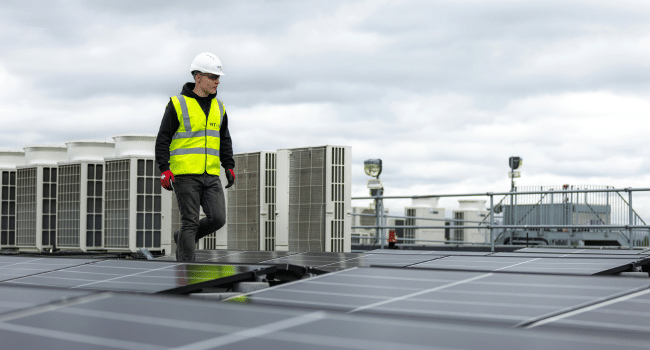Table of Contents
At first glance, a roof is a roof. It shelters, protects, and completes the architecture of a building. But when you peek beneath the shingles—or beneath the industrial metal sheets—the differences between residential and commercial roofing become not just clear, but critical. Whether you’re a homeowner planning a renovation or a business owner navigating property upgrades, understanding how these two categories of roofing diverge can help you make smarter, more informed decisions.
Let’s follow the journey of two different projects—one, a suburban family home needing an upgrade, and the other, a sprawling warehouse facility with roofing concerns of its own.
Foundations and Footprints
Picture a two-story home in a quiet neighborhood. The roofline has familiar peaks and angles, a triangular silhouette visible from the curb. Residential roofs tend to have steep slopes, driven more by design than functionality. The materials used—shingles, tiles, or even wood shakes—are chosen as much for curb appeal as for durability.
Now jump to the warehouse. It stretches across a block, with a flat or low-slope roof. There are no elegant gables here. Instead, this roof prioritizes function: space for HVAC units, drainage systems designed to manage water over a wide surface, and easy access for maintenance crews.
The sheer scale and shape differences are among the first things that separate commercial roofing from its residential counterpart. The structural demands and architectural goals aren’t the same—and neither are the solutions.
Installation: Not Just a Bigger Job
It might seem intuitive to think that installing a roof on a large commercial building is just like a house, but more of it. That’s a myth. While the core principles—layering, sealing, and insulating—remain consistent, the execution changes dramatically.
Commercial roofs often require more complex materials such as modified bitumen, built-up roofing systems (BUR), or thermoplastic membranes like TPO and PVC. These materials are heat-welded or chemically bonded, demanding specialized training and equipment. The roof installation process is logistically intricate, requiring planning for ventilation, water lines, and rooftop equipment.
Compare this to residential roofing, where asphalt shingles and underlayment materials can be installed over the course of a few days by a skilled crew. The process, while meticulous, is faster and generally more straightforward.
Working with a seasoned roofing company ensures both types of installations are handled properly. One such name familiar in the industry is Pinnacle Roofing Group, recognized for their adaptability in both residential and commercial projects.
Performance and Purpose
Roofing systems serve the needs of the building beneath them. A home needs protection from storms, insulation from the cold, and an aesthetic that suits its style. A commercial structure requires endurance—support for machinery, resistance to industrial pollutants, and long-term cost-effectiveness.
Residential roofs emphasize weather resistance and visual appeal. You’ll find homeowners prioritizing color, pattern, and texture, alongside features like skylights and solar panel integration.
Commercial roofs lean heavily into functionality. It’s not unusual for these structures to have reflective coatings to reduce heat absorption or reinforcements to handle foot traffic. Longevity and performance under constant use take precedence over aesthetics.
Maintenance Requirements
One of the most surprising differences lies in upkeep. Residential roofing is relatively hands-off, with annual inspections and occasional repairs enough to keep things secure. Issues are usually visible—missing shingles, water stains on ceilings—and quick to address.
Commercial roofing maintenance is more involved. Flat roofs are more prone to pooling, punctures, and leaks. A single undetected crack in a membrane can lead to costly damage. Routine inspections are essential, often multiple times a year, especially for buildings with rooftop systems.
Moreover, access and safety procedures for commercial roofing maintenance are more rigorous. They often require safety harnesses, ladders, and designated walkways to comply with OSHA regulations.
Costs and Timelines
Another difference that becomes quickly apparent is cost. Naturally, a commercial roof tends to be more expensive due to its size, complexity, and material requirements. But it’s not just about price tags—it’s also about budgeting timelines and workforce availability.
Commercial projects often require permits, inspections, and specialized contractors, adding layers of bureaucracy and planning. A commercial roof installation can take weeks or even months, depending on weather conditions and structural challenges.
In contrast, residential roofs are more agile. Installation and replacements are often completed within days, making them more accessible in terms of budget and logistics for homeowners.
Warranties and Lifespan
Finally, there’s the long view. A typical residential roof might offer a warranty of 20–30 years, depending on materials and maintenance. Commercial roofs, while built to last, depend more heavily on regular upkeep and usage patterns. Some membranes offer warranties up to 40 years, but only with documented maintenance logs.
For both categories, proper installation and post-project support from a reputable roofing company can make or break the long-term value of the investment.
So, Which One Is More Complex?
If you’re wondering whether commercial or residential roofing is the more “difficult” of the two, there’s no clear winner—it depends on the perspective. Residential roofing requires precision, design sense, and homeowner coordination. Commercial roofing demands technical expertise, material knowledge, and logistical planning.
Both are vital, and both benefit immensely from expertise. That’s why professionals in the field play such an essential role in advising clients and delivering quality outcomes.
